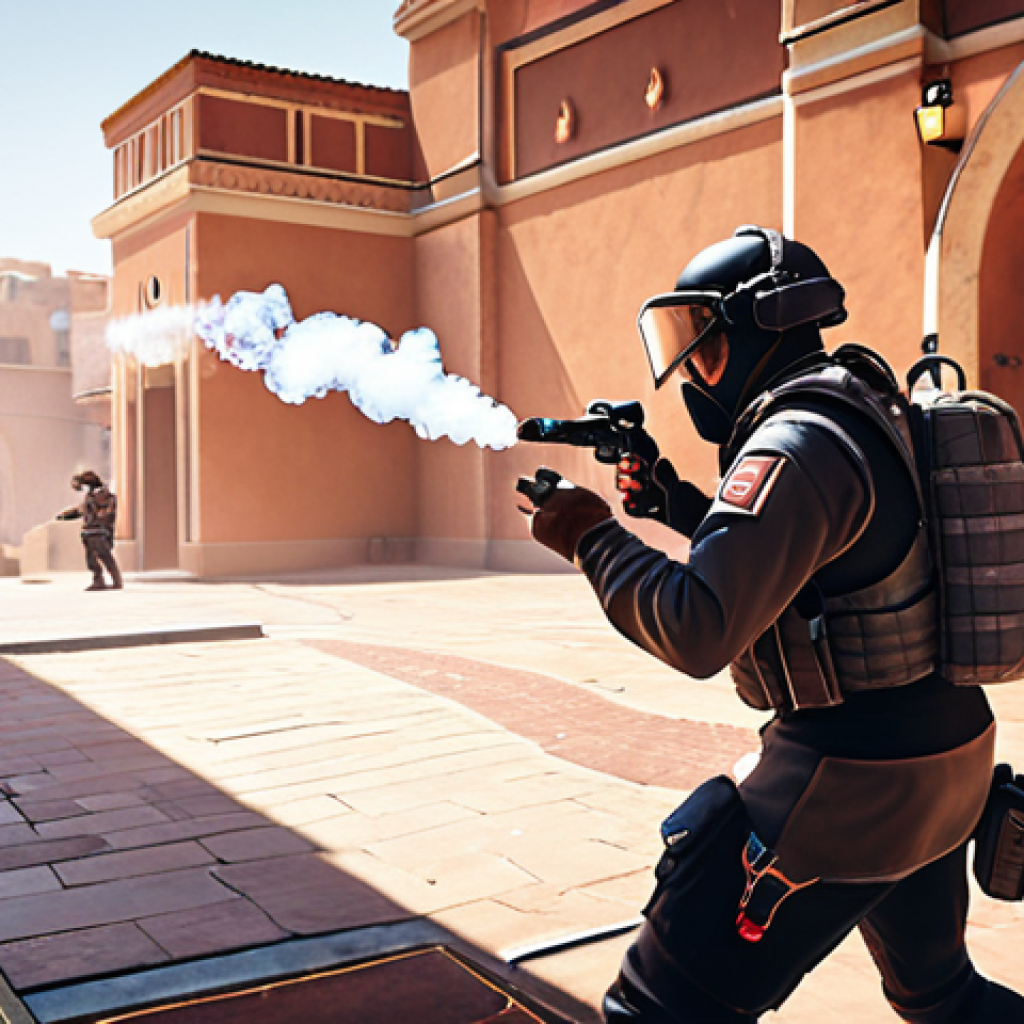Alright, buckle up, Valorant enthusiasts! Ever feel like you’re running around in circles on a map, never quite knowing where to plant or how to defend effectively?
Yeah, me too. It’s frustrating, especially when the opposing team seems to have a sixth sense. Valorant’s maps are intricate puzzles, and mastering them is key to climbing the ranks.
After countless hours playing and analyzing, I’ve put together a guide to help you navigate these battlegrounds like a pro. This isn’t just about callouts; it’s about understanding flow, chokepoints, and strategies that can give you a serious edge.
Let’s dive in and get a clear understanding below!
Alright, buckle up, Valorant enthusiasts! Ever feel like you’re running around in circles on a map, never quite knowing where to plant or how to defend effectively?
Yeah, me too. It’s frustrating, especially when the opposing team seems to have a sixth sense. Valorant’s maps are intricate puzzles, and mastering them is key to climbing the ranks.
After countless hours playing and analyzing, I’ve put together a guide to help you navigate these battlegrounds like a pro. This isn’t just about callouts; it’s about understanding flow, chokepoints, and strategies that can give you a serious edge.
Let’s dive in and get a clear understanding below!
Understanding Map Flow: The Key to Anticipation

Valorant maps are designed with specific pathways and chokepoints that dictate how the game unfolds. It’s not enough to just know the callouts; you need to understand how players tend to move around the map based on the game situation.
When I first started playing, I’d get caught off guard constantly because I was only focusing on my immediate surroundings. Now, I try to visualize the entire map in my head, predicting where enemies are likely to be based on where they were last seen and what objectives are at stake.
1. Identifying Chokepoints and Controlling Space
Chokepoints are narrow passages or doorways that naturally funnel players into specific areas. Think of the B Main entrance on Bind, or Mid on Ascent.
These areas are high-traffic zones and are often the site of intense firefights. Successfully controlling these chokepoints gives your team a significant advantage.
How? By limiting the enemy’s movement options, making them predictable, and creating opportunities for coordinated attacks. For example, on Bind, a well-placed smoke at B Main combined with a teammate watching from Hookah can effectively shut down an entire push.
I remember one game where we were down 11-3 on Bind, but we turned it around by focusing on controlling B Main with strategic utility usage. It completely disrupted their attack patterns and allowed us to pick them off one by one.
2. Reading Rotations and Anticipating Enemy Movements
This is where understanding map flow really shines. After the initial contact, players will often rotate to other parts of the map to either support their teammates or attempt a flank.
By paying attention to the minimap, listening for footsteps, and analyzing the timing of events, you can often predict these rotations before they happen.
Let’s say you see three enemies pushing A on Ascent. Common sense dictates that the remaining two are likely rotating towards B or lurking mid. Communicating this information to your team allows you to set up crossfires, prepare for the flank, and potentially catch the enemy off guard.
There was this one match on Split where I anticipated their rotation from A to B and pre-fired the corner, netting myself a clean double kill. It’s all about reading the signs and reacting accordingly.
Mastering Callouts and Communication
Knowing the callouts is non-negotiable. If you’re calling out “He’s in the corner,” you’re not giving your team nearly enough information. “He’s in Heaven on Ascent” is much more precise and allows your teammates to react accordingly.
But it goes beyond just knowing the names of the locations; it’s about communicating effectively and efficiently.
1. Using Clear and Concise Language
Time is of the essence in Valorant. There’s no time for lengthy descriptions or vague statements. Get straight to the point and use clear, concise language.
Instead of saying “There’s a guy over there by that thing,” say “One at B site, default plant.” The more specific you can be, the better. This is something I’ve had to work on myself.
I used to ramble on with unnecessary details, but I’ve learned to cut out the fluff and focus on the essential information. My team appreciates it, and we win more rounds because of it.
2. Active Listening and Information Sharing
Communication is a two-way street. It’s not enough to just talk; you need to listen to your teammates and actively share information. If you hear footsteps behind you, call it out immediately.
If you see an enemy using an ability, let your team know. The more information you can gather and share, the better your team’s chances of success. I remember playing a game on Icebox where a teammate constantly called out enemy positions, even when he was dead.
It allowed us to anticipate their moves and ultimately win the game. It’s amazing how much of a difference active communication can make.
Utilizing Smokes and Utility Effectively
Smokes, flashes, and other utility abilities are essential tools for controlling space, disrupting enemy movements, and creating opportunities for your team.
But simply throwing them out randomly is not enough. You need to understand how to use them effectively in different situations.
1. Strategic Smoke Placement
Smokes can be used to block vision, create cover, and isolate enemies. The key is to place them strategically in order to maximize their impact. For example, on Bind, smoking off the entrance to B site can prevent the enemy from rushing in and give your team time to set up a defense.
Or, smoking off Heaven on Ascent can prevent the enemy from getting a good angle on your team. I’ve seen so many players waste their smokes by throwing them ineffectively.
Take the time to learn the best smoke spots on each map and practice your placement.
2. Combining Utility for Maximum Impact
One of the most effective ways to use utility is to combine it with other abilities. For example, flashing an enemy who is hiding behind a smoke can catch them off guard and make them an easy target.
Or, using a Molotov to flush an enemy out of cover can create an opening for your team to push. There’s this great combo on Breeze where you can smoke off the entrance to B site and then throw a grenade into the smoke.
It’s almost guaranteed to net you a kill or two. Experiment with different combinations and see what works best for you.
Adapting to Different Team Compositions and Playstyles
Every team is different, and every game is different. You need to be able to adapt your strategy based on your team composition, the enemy’s playstyle, and the current game situation.
1. Identifying Strengths and Weaknesses
Before the game even starts, take a look at your team composition and identify your strengths and weaknesses. If you have a lot of aggressive players, you might want to focus on pushing and taking map control.
If you have a lot of defensive players, you might want to focus on holding sites and waiting for the enemy to make a mistake. The same goes for the enemy team.
If they’re playing aggressively, you need to be prepared to counter their pushes. If they’re playing defensively, you need to find ways to break through their defenses.
2. Adjusting Your Strategy on the Fly
No plan survives first contact. You need to be able to adjust your strategy on the fly based on what’s happening in the game. If your initial plan isn’t working, don’t be afraid to try something new.
Maybe you need to switch up your agent, change your attack patterns, or focus on a different site. The key is to be flexible and adaptable. I’ve won so many games by simply changing my strategy mid-round.
It throws the enemy off balance and gives my team a huge advantage.
Analyzing Post-Round Data and Improving Your Game
Valorant provides a wealth of data after each round, including combat reports, heatmaps, and economic breakdowns. This data can be invaluable for identifying your strengths and weaknesses, and for improving your overall game.
1. Reviewing Combat Reports
The combat report shows you how much damage you dealt, how many kills you got, and how many times you died. It can also show you where you were positioned when you got kills or died.
This information can help you identify areas where you need to improve. For example, if you’re constantly dying in the same spot, you might need to adjust your positioning.
Or, if you’re not dealing enough damage, you might need to work on your aim.
2. Studying Heatmaps and Common Engagement Points
Heatmaps show you where players tend to congregate on the map. This information can help you identify common engagement points and plan your attacks and defenses accordingly.
For example, if you see that a lot of players are fighting in mid, you might want to focus on controlling that area. I like to review the heatmaps after each game to see where I was most effective and where I could have been more effective.
It’s a great way to learn the map and understand player behavior. Here’s a simple table summarizing key map elements and strategies:
| Map Element | Description | Strategic Use |
|---|---|---|
| Chokepoints | Narrow passages or doorways that funnel players. | Control space, limit enemy movement, create opportunities for coordinated attacks. |
| Callouts | Specific names for locations on the map. | Communicate effectively and efficiently, provide precise information to teammates. |
| Smokes | Abilities that block vision and create cover. | Control space, disrupt enemy movements, isolate enemies. |
| Rotations | Movement of players to different parts of the map. | Anticipate enemy movements, set up crossfires, prepare for flanks. |
| Utility Combos | Combining different abilities for maximum impact. | Catch enemies off guard, flush enemies out of cover, create openings for your team. |
Maintaining Composure and a Positive Mindset
Valorant can be a frustrating game. You’re going to lose rounds, you’re going to make mistakes, and you’re going to encounter toxic players. The key is to maintain your composure and a positive mindset.
1. Staying Calm Under Pressure
It’s easy to get tilted when things aren’t going your way. But getting angry or frustrated will only make things worse. Take a deep breath, stay calm, and focus on the next round.
Don’t dwell on your mistakes; learn from them and move on. I used to rage so hard when I lost a clutch, but I’ve learned to control my emotions and focus on improving.
It’s made a huge difference in my gameplay.
2. Encouraging Teamwork and Positive Communication
A positive attitude can be contagious. Encourage your teammates, offer constructive criticism, and avoid negativity. Remember, you’re all working towards the same goal.
If you encounter toxic players, don’t engage with them. Mute them and focus on playing your best. Teamwork and positive communication are essential for success in Valorant.
So, there you have it, folks! Mastering Valorant maps is a complex but rewarding process. By understanding map flow, mastering callouts, utilizing utility effectively, adapting to different team compositions, analyzing post-round data, and maintaining a positive mindset, you can significantly improve your game and climb the ranks.
Good luck out there, and remember to have fun! Alright, buckle up, Valorant enthusiasts! Ever feel like you’re running around in circles on a map, never quite knowing where to plant or how to defend effectively?
Yeah, me too. It’s frustrating, especially when the opposing team seems to have a sixth sense. Valorant’s maps are intricate puzzles, and mastering them is key to climbing the ranks.
After countless hours playing and analyzing, I’ve put together a guide to help you navigate these battlegrounds like a pro. This isn’t just about callouts; it’s about understanding flow, chokepoints, and strategies that can give you a serious edge.
Let’s dive in and get a clear understanding below!
Understanding Map Flow: The Key to Anticipation
Valorant maps are designed with specific pathways and chokepoints that dictate how the game unfolds. It’s not enough to just know the callouts; you need to understand how players tend to move around the map based on the game situation. When I first started playing, I’d get caught off guard constantly because I was only focusing on my immediate surroundings. Now, I try to visualize the entire map in my head, predicting where enemies are likely to be based on where they were last seen and what objectives are at stake.
1. Identifying Chokepoints and Controlling Space
Chokepoints are narrow passages or doorways that naturally funnel players into specific areas. Think of the B Main entrance on Bind, or Mid on Ascent. These areas are high-traffic zones and are often the site of intense firefights. Successfully controlling these chokepoints gives your team a significant advantage. How? By limiting the enemy’s movement options, making them predictable, and creating opportunities for coordinated attacks. For example, on Bind, a well-placed smoke at B Main combined with a teammate watching from Hookah can effectively shut down an entire push. I remember one game where we were down 11-3 on Bind, but we turned it around by focusing on controlling B Main with strategic utility usage. It completely disrupted their attack patterns and allowed us to pick them off one by one.
2. Reading Rotations and Anticipating Enemy Movements
This is where understanding map flow really shines. After the initial contact, players will often rotate to other parts of the map to either support their teammates or attempt a flank. By paying attention to the minimap, listening for footsteps, and analyzing the timing of events, you can often predict these rotations before they happen. Let’s say you see three enemies pushing A on Ascent. Common sense dictates that the remaining two are likely rotating towards B or lurking mid. Communicating this information to your team allows you to set up crossfires, prepare for the flank, and potentially catch the enemy off guard. There was this one match on Split where I anticipated their rotation from A to B and pre-fired the corner, netting myself a clean double kill. It’s all about reading the signs and reacting accordingly.
Mastering Callouts and Communication
Knowing the callouts is non-negotiable. If you’re calling out “He’s in the corner,” you’re not giving your team nearly enough information. “He’s in Heaven on Ascent” is much more precise and allows your teammates to react accordingly. But it goes beyond just knowing the names of the locations; it’s about communicating effectively and efficiently.
1. Using Clear and Concise Language
Time is of the essence in Valorant. There’s no time for lengthy descriptions or vague statements. Get straight to the point and use clear, concise language. Instead of saying “There’s a guy over there by that thing,” say “One at B site, default plant.” The more specific you can be, the better. This is something I’ve had to work on myself. I used to ramble on with unnecessary details, but I’ve learned to cut out the fluff and focus on the essential information. My team appreciates it, and we win more rounds because of it.
2. Active Listening and Information Sharing
Communication is a two-way street. It’s not enough to just talk; you need to listen to your teammates and actively share information. If you hear footsteps behind you, call it out immediately. If you see an enemy using an ability, let your team know. The more information you can gather and share, the better your team’s chances of success. I remember playing a game on Icebox where a teammate constantly called out enemy positions, even when he was dead. It allowed us to anticipate their moves and ultimately win the game. It’s amazing how much of a difference active communication can make.
Utilizing Smokes and Utility Effectively
Smokes, flashes, and other utility abilities are essential tools for controlling space, disrupting enemy movements, and creating opportunities for your team. But simply throwing them out randomly is not enough. You need to understand how to use them effectively in different situations.
1. Strategic Smoke Placement
Smokes can be used to block vision, create cover, and isolate enemies. The key is to place them strategically in order to maximize their impact. For example, on Bind, smoking off the entrance to B site can prevent the enemy from rushing in and give your team time to set up a defense. Or, smoking off Heaven on Ascent can prevent the enemy from getting a good angle on your team. I’ve seen so many players waste their smokes by throwing them ineffectively. Take the time to learn the best smoke spots on each map and practice your placement.
2. Combining Utility for Maximum Impact
One of the most effective ways to use utility is to combine it with other abilities. For example, flashing an enemy who is hiding behind a smoke can catch them off guard and make them an easy target. Or, using a Molotov to flush an enemy out of cover can create an opening for your team to push. There’s this great combo on Breeze where you can smoke off the entrance to B site and then throw a grenade into the smoke. It’s almost guaranteed to net you a kill or two. Experiment with different combinations and see what works best for you.
Adapting to Different Team Compositions and Playstyles
Every team is different, and every game is different. You need to be able to adapt your strategy based on your team composition, the enemy’s playstyle, and the current game situation.
1. Identifying Strengths and Weaknesses
Before the game even starts, take a look at your team composition and identify your strengths and weaknesses. If you have a lot of aggressive players, you might want to focus on pushing and taking map control. If you have a lot of defensive players, you might want to focus on holding sites and waiting for the enemy to make a mistake. The same goes for the enemy team. If they’re playing aggressively, you need to be prepared to counter their pushes. If they’re playing defensively, you need to find ways to break through their defenses.
2. Adjusting Your Strategy on the Fly
No plan survives first contact. You need to be able to adjust your strategy on the fly based on what’s happening in the game. If your initial plan isn’t working, don’t be afraid to try something new. Maybe you need to switch up your agent, change your attack patterns, or focus on a different site. The key is to be flexible and adaptable. I’ve won so many games by simply changing my strategy mid-round. It throws the enemy off balance and gives my team a huge advantage.
Analyzing Post-Round Data and Improving Your Game
Valorant provides a wealth of data after each round, including combat reports, heatmaps, and economic breakdowns. This data can be invaluable for identifying your strengths and weaknesses, and for improving your overall game.
1. Reviewing Combat Reports
The combat report shows you how much damage you dealt, how many kills you got, and how many times you died. It can also show you where you were positioned when you got kills or died. This information can help you identify areas where you need to improve. For example, if you’re constantly dying in the same spot, you might need to adjust your positioning. Or, if you’re not dealing enough damage, you might need to work on your aim.
2. Studying Heatmaps and Common Engagement Points
Heatmaps show you where players tend to congregate on the map. This information can help you identify common engagement points and plan your attacks and defenses accordingly. For example, if you see that a lot of players are fighting in mid, you might want to focus on controlling that area. I like to review the heatmaps after each game to see where I was most effective and where I could have been more effective. It’s a great way to learn the map and understand player behavior.
Here’s a simple table summarizing key map elements and strategies:
| Map Element | Description | Strategic Use |
|---|---|---|
| Chokepoints | Narrow passages or doorways that funnel players. | Control space, limit enemy movement, create opportunities for coordinated attacks. |
| Callouts | Specific names for locations on the map. | Communicate effectively and efficiently, provide precise information to teammates. |
| Smokes | Abilities that block vision and create cover. | Control space, disrupt enemy movements, isolate enemies. |
| Rotations | Movement of players to different parts of the map. | Anticipate enemy movements, set up crossfires, prepare for flanks. |
| Utility Combos | Combining different abilities for maximum impact. | Catch enemies off guard, flush enemies out of cover, create openings for your team. |
Maintaining Composure and a Positive Mindset
Valorant can be a frustrating game. You’re going to lose rounds, you’re going to make mistakes, and you’re going to encounter toxic players. The key is to maintain your composure and a positive mindset.
1. Staying Calm Under Pressure
It’s easy to get tilted when things aren’t going your way. But getting angry or frustrated will only make things worse. Take a deep breath, stay calm, and focus on the next round. Don’t dwell on your mistakes; learn from them and move on. I used to rage so hard when I lost a clutch, but I’ve learned to control my emotions and focus on improving. It’s made a huge difference in my gameplay.
2. Encouraging Teamwork and Positive Communication
A positive attitude can be contagious. Encourage your teammates, offer constructive criticism, and avoid negativity. Remember, you’re all working towards the same goal. If you encounter toxic players, don’t engage with them. Mute them and focus on playing your best. Teamwork and positive communication are essential for success in Valorant.
So, there you have it, folks! Mastering Valorant maps is a complex but rewarding process. By understanding map flow, mastering callouts, utilizing utility effectively, adapting to different team compositions, analyzing post-round data, and maintaining a positive mindset, you can significantly improve your game and climb the ranks.
Good luck out there, and remember to have fun!
Wrapping Up
Mastering Valorant maps takes time and dedication, but it’s an investment that pays off. Keep practicing, analyzing your gameplay, and communicating with your team. Don’t be afraid to experiment with different strategies and find what works best for you. And most importantly, remember to have fun and enjoy the game! Now, go out there and dominate those maps!
Useful Tips and Tricks
1. Always warm up in the practice range before jumping into a competitive match. It helps sharpen your aim and get you in the right mindset.
2. Watch professional Valorant players and analyze their strategies. You can learn a lot by observing how they approach different situations.
3. Record your own gameplay and review it later. It’s a great way to identify your mistakes and areas for improvement.
4. Customize your crosshair and sensitivity settings to find what feels most comfortable for you. A well-tuned setup can significantly improve your accuracy.
5. Take breaks and avoid playing for extended periods of time. Burnout can negatively impact your performance. Get up, stretch, and come back refreshed.
Key Takeaways
Understanding map flow is crucial for anticipating enemy movements and controlling space.
Clear and concise communication is essential for effective teamwork.
Strategic use of utility can disrupt enemy pushes and create opportunities for your team.
Adapting to different team compositions and playstyles is key to success.
Analyzing post-round data can help you identify areas for improvement and refine your strategies.
Frequently Asked Questions (FAQ) 📖
Q: I’m new to Valorant. Which map should I focus on learning first?
A: Honestly, start with Ascent. It’s a relatively straightforward map with clear divisions between attacker and defender territory. The mid control is crucial, and understanding rotations there will pay off big time.
Plus, the map has a good mix of long and short-range engagements, which will help you get comfortable with different weapons and playstyles. I remember when I first started, I spent hours just walking around Ascent in custom games, learning the callouts and different angles.
It sounds boring, but it made a huge difference when I hopped into real matches!
Q: What’s the biggest mistake players make when playing on Breeze?
A: Without a doubt, it’s tunnel vision! Breeze is HUGE, and if you’re just staring down one lane, you’re going to get flanked. Pay close attention to your minimap and listen for footsteps.
Communication is key on Breeze; let your teammates know if you’re pushing, holding, or rotating. I’ve seen so many rounds lost because players are too focused on their own little world and don’t realize the enemy is right behind them.
A little awareness goes a long way on this map!
Q: Any tips for holding down the B site on Bind as a defender?
A: Okay, so Bind’s B site is a tricky one. The best approach, in my experience, is a combination of utility and positioning. Use smokes to block off the attacker’s entry points (like B Window and B Short), and have one player watching hookah, ideally with a weapon like an Operator or a Judge for close-quarters combat.
The key is to delay the attackers as much as possible while your teammates rotate in. And don’t be afraid to fall back and play retake if you’re outnumbered!
I remember one match where I was playing Cypher and basically walled off the entire B site with my Cyber Cages. It was hilarious watching the attackers stumble around in the dark!
📚 References
Wikipedia Encyclopedia
구글 검색 결과
구글 검색 결과
구글 검색 결과
구글 검색 결과
구글 검색 결과






